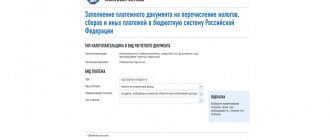Input data
In this material we will look at a simple example to understand how an individual entrepreneur should act when calculating taxes and contributions . Our entrepreneur will meet the following criteria:
- Pays tax at a rate of 6% , that is, it uses the simplified tax system with the object’s income.
- Does not attract hired workers.
- Does not work with individuals, therefore does not use a cash register. The contractors of the individual entrepreneur are entrepreneurs and legal entities with whom he pays through a bank account.
Are there taxes that reduce the tax base?
There are three tax regimes in which expenses must be taken into account when determining the tax base - OSNO, simplified tax system and unified agricultural tax.
Organizations on OSNO pay income tax, entrepreneurs pay personal income tax. When calculating, you can recognize expenses that meet three criteria:
- confirmed by documents;
- economically justified;
- lead to future income.
The amounts of taxes, fees, customs duties and insurance premiums can be taken into account in other expenses when calculating income tax. This rule is enshrined in Art. 264 Tax Code of the Russian Federation. But there are exceptions, which are listed in Art. 270 of the Tax Code of the Russian Federation: sanctions to the budget, tax for excess environmental pollution, VAT to the buyer, amounts of taxes previously included in expenses, etc.
For the simplified tax system of 15%, all expenses that reduce the tax base are listed in Art. 346.16 Tax Code of the Russian Federation. These also include customs duties, taxes and fees, insurance premiums, and in some cases VAT.
It turns out that taxes can actually reduce the tax base. But it's not that simple. As always, there are many nuances and controversial situations in tax legislation, which we will try to sort out.
What must be paid
An entrepreneur using the simplified tax system is exempt from paying many taxes:
- Personal income tax in relation to own income;
- VAT (with some exceptions, for example, on export transactions);
- Property tax applied when carrying out business activities (with the exception of real estate, which are taxed based on cadastral value).
The only tax that a simplified entrepreneur who works independently pays is the tax in connection with the application of the simplified tax system. In our case, this is 6% of the income received. The tax is paid throughout the year in advance payments :
- for the first quarter - no later than April 25;
- for half a year - no later than July 25;
- for 9 months - no later than October 25.
The final payment is made at the end of the tax period (year) until April 30 of the following year.
The rule applies: if the last day of the payment deadline falls on a weekend, then this deadline is postponed to the first working day.
There are also sectoral taxes that are paid when carrying out specific activities (for example, water tax, mineral extraction tax and others). Their tax under the simplified tax system does not replace them.
In addition to taxes, individual entrepreneurs are required to pay insurance contributions to the Pension and Medical Funds . Starting this year, the amounts of contributions have been fixed, whereas previously they were tied to the minimum wage. For 2021, the entrepreneur must pay for himself:
- Pension insurance contributions : From income up to 300 thousand rubles - 26,545 rubles. Payable by December 31, 2021.
- For income exceeding 300 thousand rubles - 1%. Payable by July 1, 2021. A maximum has been set equal to 8 times the amount of fixed contributions from paragraph 1. That is, the maximum individual entrepreneur will pay is 26,545 * 8 = 212,360 rubles.
Note! The above figures are current for 2018. Higher amounts of insurance premiums have been determined for 2021 and 2021 (Article 430 of the Tax Code).
Accounting
In terms of accounting, everything is quite simple. An individual entrepreneur does not keep accounts and does not submit annual financial statements. However, he is required to keep tax records. For this purpose, the entrepreneur must fill out a book of income and expenses for entities using the simplified taxation system. In it, the entrepreneur records all his income transactions.
Expenses of an individual entrepreneur on the simplified tax system with the object “income” are not taken into account, therefore column 5 of Section I of the accounting book is not filled out. However, it is necessary to reflect the insurance premiums paid in the book. They are reflected in Section IV.
Using the book of income and expenses, the individual entrepreneur calculates the tax payable in the reporting period. Information is entered into the book based on an extract from the current account.
Tax calculation
Calculating the advance tax payment is not difficult. It is calculated according to the formula: Advance payment = Tax base * 6 / 100, where the tax base is equal to the entrepreneur’s income for the reporting period on an accrual basis.
For example, an individual entrepreneur earned (cumulative income):
- for the first quarter - 0 rubles;
- for the first half of the year - 20 thousand rubles;
- for 9 months - 130 thousand rubles;
- for the year - 295 thousand rubles.
Advance payments (before deduction of insurance premiums) will be:
- for the first half of the year - 20,000 * 6 / 100 = 1,200 rubles;
- for 9 months - 130,000 * 6 / 100 = 7,800 rubles;
- for the year - 295,000 * 6 / 100 = 17,700 rubles;
Further, the advance payment can be reduced by the amount of insurance premiums paid during the period. The reduction mechanism is discussed in detail below. In addition, the tax payment is subject to reduction by the amount of advance payments previously paid in the year for previous periods. The formula takes the form:
Payment amount for the period = Advance payment for the period - Amount of contributions paid in the period - Advance payment paid for previous periods of the year
What counts as income
In terms of income accounting, there are the following rules:
- Income is accounted for on a cash basis. This means that they are recognized on the date they are actually received. The individual entrepreneur from our example receives his income to the bank, therefore, they are recognized on the date of receipt of funds into his current account.
Note! This rule also applies to prepayments against future deliveries. The entrepreneur must include this amount in his income on the date of receipt of the advance payment. If the transaction does not take place, that is, the advance payment is returned, this operation is reflected in the book of income and expenses in the period when the return was actually made. It must be indicated with a minus sign. Accordingly, this amount will reduce taxable income.
- Some types of income are not included in the taxable base , namely: Amounts of loans and borrowings, as well as amounts of funds received to repay loans and borrowings.
- Amounts of income that are subject to other tax rates. This includes bond coupons, dividends and other types of income.
- Amounts of income that are taxed in accordance with other taxation regimes. Often an entrepreneur combines two systems, for example, simplified tax system and UTII or simplified tax system and patent.
- Amounts of funds that are not income. This includes, for example, funds for the return of defective goods, erroneously credited by the bank or amounts transferred by the counterparty.
The following table shows a fragment of the Book of Income and Expenses of our individual entrepreneur for the first half of the year.
Table 5. Example of filling out Section I of the Income and Expense Accounting Book
| No. | Date and number of the primary document | Contents of operation | Income taken into account when calculating the tax base | Expenses taken into account when calculating the tax base |
| 1 | 2 | 3 | 4 | 5 |
| 1 | 20.04.2018 № 1 | Payment under agreement dated April 20, 2018 No. 1 | 20000 | |
| 2 | 23.04.2018 № 2 | Prepayment under agreement dated April 23, 2018 No. 2 | 30000 | |
| 3 | 30.04.2018 № 3 | Refund of advance payment under agreement dated 04/23/2018 No. 2 | -30000 | |
| Total for the second quarter | 20000 | |||
| Total for the half year | 20000 |
How to reduce the tax of individual entrepreneurs on the simplified tax system with employees
What contributions and payments can be used to reduce tax - the composition of the deduction:
- mandatory insurance premiums paid by the entrepreneur for himself;
- mandatory insurance contributions for employees;
- sick leave for the first three days, paid at the expense of the employer;
- contributions under voluntary insurance contracts in favor of employees in the event of their temporary disability.
View
the list in detail and with comments
An entrepreneur who has employees and/or pays remuneration to individuals has the right to reduce the amount of the calculated “simplified” tax (advance payments) for the costs of paying:
- mandatory insurance premiums paid for your insurance. These include: payments in a minimum fixed amount to the Pension Fund (pension insurance) and the FFOMS (compulsory health insurance);
- payments to the Russian Federation in the amount of 1%, paid on income exceeding 300,000 rubles.
It is not worth relying on the Letter of the Ministry of Finance (No. 03-11-09/57011 dated October 6, 2015) stating that 1% contributions to the Pension Fund cannot be included in the deduction; it was withdrawn (for more details, see the information above, in the section for individual entrepreneurs without workers).
- insurance premiums from payments to its employees and/or other individuals (for example, under contracts for the provision of services, etc.). Such payments include insurance contributions: for compulsory pension insurance;
- for compulsory social insurance in case of temporary disability and in connection with maternity;
- for compulsory health insurance;
- for compulsory social insurance against accidents at work and occupational diseases (contributions in case of injury);
- temporary disability benefits;
The entrepreneur, at his own expense, pays temporary disability benefits for the first three days of incapacity for work - these amounts are deducted provided that they are not covered by insurance payments under voluntary insurance contracts (VHI). In this case, the benefit should not be related to industrial accidents and occupational diseases.
To justify the deduction, the entrepreneur must have supporting documents: a certificate of temporary incapacity for work of the employee and a document confirming that the employee received payment (for example, an expense cash order).
The amount of deduction in the form of sick leave is not reduced by the amount of personal income tax calculated from the benefit. If an entrepreneur pays an additional amount to sick leave benefits up to the employee’s actual average earnings, these costs are not deducted under the “simplified” tax.
An employer may conclude a voluntary health insurance agreement for the benefit of employees. Such an agreement may provide that when an employee goes on sick leave, an insurance payment is paid. In this case, the deduction does not include the costs of paying for sick leave (in fact, there will be none), but payments under the contract (see the next paragraph).
- payments (contributions) under voluntary personal insurance contracts in favor of employees in the event of their temporary disability (except for industrial accidents and occupational diseases).
To receive a deduction for these payments, the contract must stipulate, among other conditions, that the amount of the insurance payment to the employee does not exceed the legally established amount of temporary disability benefits and is paid only for the first three days of incapacity.
How much can you reduce the “simplified” tax - the amount of deduction:
- in the amount of amounts actually paid in the reporting period related to deductions, but not more than 50% of the tax (advance payment).
That is, advance payments and taxes can be reduced by individual entrepreneurs by no more than half. Consequently, if the total amount of the above payments (deductions) amounts to more than half of the calculated advance payment (tax), then the advance payment (tax) payable can only be reduced by 50%.
How to calculate an advance payment (tax) taking into account deductions - formula:
Formula for calculating advance payment (tax) according to the simplified tax system for an individual entrepreneur*
| Advance payment | = | Income for the period | x | Rate of the simplified tax system | – | Expenses paid in the period related to deductions | – | Previously paid advance tax payments |
in this case, the advance payment (tax) cannot be less than:
Minimum payment (tax)*
| Minimum advance payment | = | Income for the period | x | Rate of the simplified tax system | x | 50% |
*If the entrepreneur is a payer of the trade tax (introduced in a number of regions), it is also possible to apply a deduction for the trade tax, but it is not subject to the 50% limit.
Calculation of insurance premiums
For the year in which the entrepreneur registered, he must pay contributions not in full, but in proportion to the number of days that he was considered an individual entrepreneur . Let's say it was entered into the register on April 16, 2021 . This means that in 2021 he is an entrepreneur for 8 full months and another 15 days of April. The calculation will be as follows:
- Pension contributions from income up to 300 thousand rubles:
- 26545 / 12 * 8 = 17696.67 rubles - for 8 months of 2021;
- 26545 / 12 / 30 * 15 = 1106.04 rubles - for 15 days of April;
- 17696.67 + 1106.04 = 18802.71 - total in the Pension Fund.
- Medical fees:
- 5840 / 12 * 8 = 3893.33 rubles - for 8 months of 2021;
- 5840 / 12 / 30 * 15 = 243.33 rubles - for 15 days of April;
- 3893.33 + 243.33 = 4136.66 - total in the Compulsory Medical Insurance Fund.
In total, an individual entrepreneur registered on April 16, 2021 must pay up to 300 thousand contributions in the amount of 18,802.71 + 4,136.66 = 22,939.37 rubles .
Features of paying insurance premiums to deduct their amount from advance payments
An individual entrepreneur without employees has the right to reduce advance tax payments by the amount of insurance premiums that he paid in the tax (reporting) period . Moreover, the tax amount can be reduced down to zero. In other words, if during the reporting period the entrepreneur’s income was small, and the contributions paid completely covered it, he may not pay tax.
The rules for reducing the advance payment are as follows:
- It is reduced within the calculated amount . That is, if the contributions paid are greater than the amount of the advance payment, the tax cannot go negative. Let’s say the advance payment is 15 thousand rubles, and the amount of contributions paid is 17 thousand rubles. The payment will decrease by 15 thousand and will be equal to zero, and the “extra” 2 thousand rubles will not be transferred and will not be compensated.
- It is reduced by the amount actually paid during that period , not calculated for the period. It does not matter for what period the tax was paid - for the current period (advance payment), for the tax year (surcharge on income over 300 thousand rubles) or for previous years (payment of debt). For example, in May 2018, an entrepreneur made an additional tax payment for 2021 on income exceeding 300 thousand rubles. By this amount, the entrepreneur will be able to reduce the advance tax payment for the first half of 2018.
Let's look at how paying contributions affects the amount of the advance payment. 20,000 rubles in April . Let's assume that he doesn't expect more income for the first half of the year. The amount of the advance tax payment for the tax for the first half of the year will be 20,000 / 100 * 6 = 1,200 rubles.
Above, we calculated that by the end of the year the individual entrepreneur must pay 22,939.37 rubles in insurance premiums. Our entrepreneur decided in April to pay 1,200 rubles towards contributions, thereby reducing the amount of the advance tax payment to zero.
Now let’s say that by the end of the summer the business of the individual entrepreneur went uphill and he managed to earn money every month from August to December. At the same time, he paid the remaining amount of insurance premiums in equal installments every month (except for April). The data is presented in Table 1.
Table 1. Income and contributions of individual entrepreneurs by month
| Month | Income | Paid dues |
| April | 20 000 | 1 200 |
| May | — | 2 718 |
| June | — | 2 718 |
| Total for six months | 20 000 | 6 636 |
| July | — | 2 718 |
| August | 50 000 | 2 718 |
| September | 60 000 | 2 718 |
| Total for 9 months | 130 000 | 14 790 |
| October | 40 000 | 2 718 |
| november | 45 000 | 2 718 |
| December | 80 000 | 2 714 |
| Total for the year | 295 000 | 22 940 |
In Table 2, individual entrepreneurs’ income, advance tax payments and contributions paid are presented as a cumulative total.
Table 2. Income, contributions and tax amounts by period (cumulative total)
| Period | Income | Advance tax payment (6%) | Actual contributions paid | Tax payment for the period taking into account contributions |
| I quarter | — | — | — | — |
| Half year | 20 000 | 1 200 | 6636* | 0 |
| 9 months | 130 000 | 7 800 | 14790* | 0 |
| Year | 295 000 | 17700 | 22940* | 0 |
*The amount of contributions paid exceeds the amount of the advance tax payment.
Now let's see what would happen if the individual entrepreneur did not pay contributions from May to August, deciding to leave them at the end of the year. The calculation results are in Table 3.
Table 3. Other procedure for paying contributions
| Month | Income | Paid dues |
| April | 20 000 | 1 200 |
| May | — | — |
| June | — | — |
| Total for six months | 20 000 | 1 200 |
| July | — | — |
| August | 50 000 | — |
| September | 60 000 | 5 000 |
| Total for 9 months | 130 000 | 6 200 |
| October | 40 000 | 5 000 |
| november | 45 000 | 5 000 |
| December | 80 000 | 6 740 |
| Total for the year | 295 000 | 22940 |
Cumulative data and advance tax amounts are in Table 4.
Table 4. Income, contributions and tax amounts by period (cumulative total)
| Period | Income | Advance tax payment | Paid dues | Payment amount for the period |
| I quarter | — | — | — | — |
| Half year | 20 000 | 1 200 | 1 200* | 0 |
| 9 months | 130 000 | 7 800 | 6200** | 400 (7800—6200-1200) |
| Year | 295 000 | 17700 | 22940* | 0 |
*The amount of contributions paid exceeds the amount of the advance tax payment.
**The amount of contributions paid is less than the amount of the advance tax payment.
This table shows that the total amount of contributions for the year exceeded the amount of tax. However, over the 9-month period, the individual entrepreneur received tax due, since the contributions at that time were paid less than the amount of the advance payment.
Is the simplified tax system tax reduced by the amount of fixed payments of individual entrepreneurs?
Tax reduction is possible according to standard 346.21. All rights of a taxpayer who uses not a full, but a simplified taxation system are recorded there. The regulation contains subclause 3.1, according to which individual entrepreneurs who do not have employees and their activities are subject to 6% taxes can reduce the duty. This happens based on the amount of funds they pay to the branch of the Pension Fund of the Russian Federation. At the same time, there are no restrictions on individual entrepreneurs on the simplified tax system (income minus expenses), reductions in insurance premiums, that is, you can completely reduce it even by 100% and there will be 0 rubles left for payment of the simplified tax system.
Deduction for contributions to the Pension Fund of the Russian Federation for individual entrepreneurs simplified tax system income
For individual entrepreneur
If the entrepreneur used the services of employees, then a reduction in deductions at the interdistrict federal tax office is possible. This happens with the money deposited in the Pension Fund (PFR) office for them, but not more than 50 percent of the payment. At the same time, he can apply a tax reduction on the number of his contributions to the branch of the Pension Fund of the Russian Federation if he has people in his company, but if the reduction is no more than 50% of the amount paid.
Attention! The employer does not have to contribute money for himself. For this reason, even if it is registered accordingly, the tax burden will not be reduced. Voluntary fees are not deductible.
Thus, in response to how an individual entrepreneur can reduce tax according to the simplified tax system, or an entrepreneur - by the amount of insurance premiums, we can answer that a person with a team can do this by the amount of calculations:
- For myself;
- For the employees of the enterprise;
- For sick leave of 3 days, which the employer pays out of his own pocket;
- For people who lost their ability to work and were voluntarily insured.
Is it possible to reduce taxes using the simplified tax system?
A reduction is also possible if an individual entrepreneur has an income of more than 300 thousand rubles and pays taxes to the branch of the Pension Fund of the Russian Federation in the amount of 1 percent.
As for the issue of contribution rates to state and non-state branches that operate on the territory of the Russian Federation, they remained the same in 2021 as last year. They can be calculated on the company’s official website, at any tax authority or in the Tax Code of the Russian Federation.
Without employees
This year, an individual entrepreneur who operates under a simplified taxation system and does not have a team can reduce the tax by the amount of assessments that he contributed to the Pension Fund of the Russian Federation for himself. In addition, he can return part of the payments for contributions to the health insurance fund and the Pension Fund of the Russian Federation if the amount of his profit is more than 300,000 rubles. Other types of calculations made, reductions and the return of money for them are not provided.
Payment of taxes and contributions
An individual entrepreneur pays all payments for himself according to the details of the tax office . To generate a payment invoice, you can use the official service of the Federal Tax Service. The first thing you need to know from the details is the budget classification code. Using it, the service can independently determine the type and name of payment. The individual entrepreneur must have all other details in the documents from the tax office and the Pension Fund.
Entrepreneurs on the simplified tax system of 6% should use the following codes (2018):
- for tax payment - KBK 182 10500 110;
- to pay contributions to the Pension Fund - 182 10210 160;
- to pay contributions to the Compulsory Medical Insurance Fund - 182 10213 160.
The generated payment order can be taken to the bank or used as a template for filling out a payment order in Internet banking.





